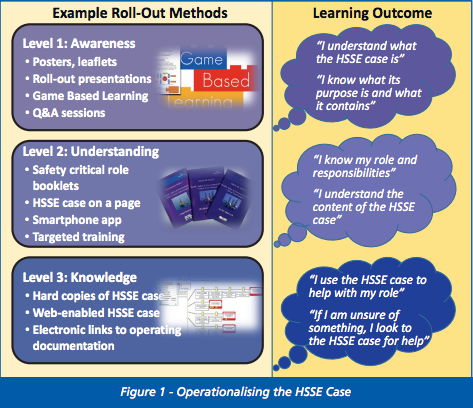The development or revision of a health, safety, security and environment (HSSE) case inevitably involves significant time and effort, with input from a wide range of people and departments. However, once the HSSE case is delivered, the opportunity to truly embed it in day-today operations is often missed, leaving the workforce thinking, “How do I use it and what is expected of me?”
Ideally the workforce will have been involved during the development of the case, for example participating in hazard workshops, reviewing output, etc. This approach has the benefit of avoiding ‘paper-based’ safety, so that the case reflects what is actually happening at the facility rather than what officebased people think is happening. But in practice only a small portion of the total workforce is likely to be involved during this development stage.
The delivery of the HSSE case therefore provides the opportunity to engage with the total workforce. However, simply asking everyone to plough through reams of content is unrealistic and doomed to failure. Similarly, a handful of Powerpoint slides is unlikely to achieve any lasting effect.
The aim of ‘operationalising’ the safety case is to provide the right information to the right people in the right way. What a technician needs to be aware of, understand or work with is quite different to that of a production supervisor, which again will be different to that of an asset manager. This is the job of the ‘roll-out’ plan: to communicate the content in a clear and unambiguous way to those who need to know.
The roll-out plan
Of course, the plan can be affected by many factors including time available, budget, size of workforce, cultural and language issues, and familiarity of the workforce with HSSE concepts, not to mention corporate and business drivers. However, an effective roll-out plan will balance these issues, and look to operationalise the case in the most efficient and cost-effective manner.

The plan should be developed in close coordination with the HSSE case custodian and the training team (if required) with the overall aim of maximising awareness, understanding and knowledge of the HSSE case, targeting areas of change and improvement. There are three levels of detail, as depicted in Figure 1:
- Raise Awareness: What is the HSSE case? What does it do?
- Develop Understanding: How do I use it? What are my roles and responsibilities?
- Deepen Knowledge: I know when to refer to the HSSE case and why; it helps me perform my job.
Posters, leaflets, presentations and Q&A sessions are simple and effective methods to increase awareness; safetycritical role booklets and user-friendly, targeted copies, extracts or summaries of the HSSE case are all useful tools to advance understanding.
Conclusion
What are the best practical approaches to address a safety / HSE case according to legal, industry and company requirements?
Find out more or register your interest in our Certificate of Professional Development in Safety / HSE Cases here.



